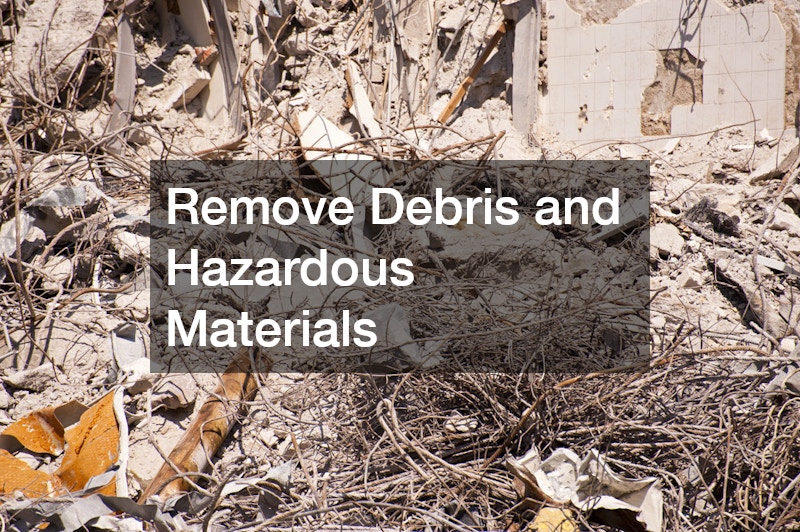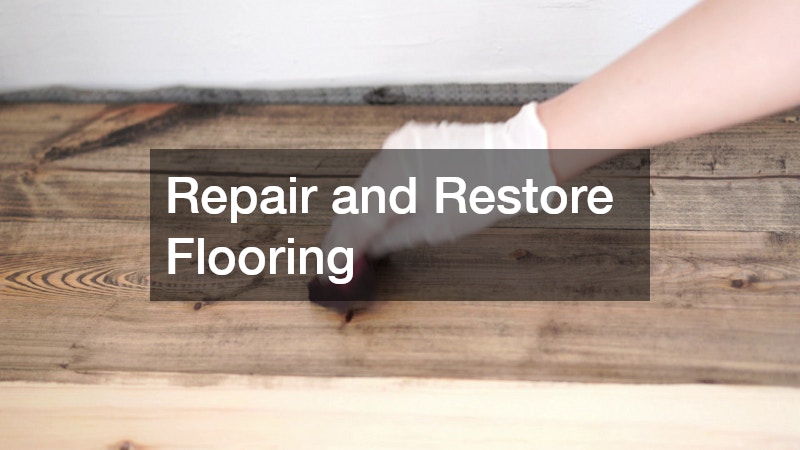Severe storms can strike suddenly, leaving homeowners with structural damage, flooding, debris, and even safety hazards. From hailstorms and tornadoes to hurricanes and wind events, the aftermath can feel overwhelming. Repairing storm damage requires a structured approach to prevent minor issues from escalating into major, costly problems.
Taking quick, organized steps not only protects your property but also ensures safety, preserves value, and minimizes stress. Knowing what to prioritize and when to involve professionals makes the restoration process more manageable.
Ensure Safety Before Doing Anything Else
The very first priority after a storm is ensuring the safety of yourself, your family, and anyone entering the property. Even seemingly minor damage can conceal serious hazards such as fallen power lines, broken windows, waterlogged flooring, and debris. Before entering your home, survey both the exterior and interior for potential dangers.
Utilities should be shut off immediately if there is flooding or structural compromise. Electricity, gas, and water can all become dangerous under storm conditions. Electrical hazards are particularly serious in areas with standing water. Even small cracks in ceilings or bowing walls should be treated as potential collapse risks. For larger-scale damage, waiting for emergency personnel or structural engineers to evaluate the property is the safest option.
Safety also extends to personal protective equipment. Wearing gloves, boots, hard hats, and eye protection can prevent injuries during initial assessment and debris removal. Taking these precautions first sets a strong foundation for all subsequent repair and restoration work.
Document the Damage for Insurance Purposes

Before beginning any cleanup or repairs, meticulously document all damage. Take comprehensive photos and videos of every affected area—roof, siding, windows, doors, interior ceilings, walls, flooring, and even landscaping. Documentation is critical when filing insurance claims, as it provides evidence of the extent of damage and the urgency of repairs.
Include close-up shots of structural damage, leaks, broken fixtures, and watermarks. A chronological log describing the timing of the storm and any immediate protective measures you took can strengthen your insurance case. For example, if you covered broken windows with tarps or removed excess water temporarily, noting that can demonstrate proactive mitigation. Well-documented evidence helps your insurer understand the scope of work and can expedite approvals for professional services like mold removal companies, water damage restorations, and roof repairs.
Assess Structural Damage and Roof Issues
Once safety and documentation are addressed, it’s critical to assess structural integrity, starting with the roof. Roofs are particularly vulnerable to hail, high winds, and falling debris. Damage can range from missing shingles and punctures to compromised underlayment, all of which can lead to leaks and water intrusion. Prioritizing roof repairs early prevents further interior damage to ceilings, walls, and insulation.
Structural assessment should also include foundations, walls, windows, doors, and load-bearing beams. Small cracks or misalignments can indicate larger underlying problems that require immediate attention. Licensed professionals are invaluable for this stage, ensuring that repairs are both safe and code-compliant. Addressing structural issues promptly reduces the risk of escalating damage and avoids costly repairs in the future. Seasonal considerations—like inspecting roof valleys for ice buildup in winter—can also influence long-term home resilience.
Address Water Intrusion Quickly

Water is often the most destructive outcome of storms. Even minor leaks can cause significant problems if left unaddressed, including mold growth, compromised insulation, warped floors, and damaged personal belongings. Professional water damage restorations services are usually necessary to extract water, dry affected areas, and stabilize the home.
Basements are particularly vulnerable, making flooded basement clean up urgent to prevent long-term damage. Industrial-grade pumps, dehumidifiers, and drying fans are often required to remove moisture efficiently. Quick action reduces the risk of mold and bacterial growth, preserves building materials, and ensures that further repairs can proceed safely. Preventive measures, like moving valuables to higher ground and using temporary barriers, can also reduce initial losses.
Inspect Plumbing and Electrical Systems
Severe storms can disrupt plumbing systems by causing pipe bursts, leaks, or pressure issues. A professional plumbing inspection ensures that any hidden damage is identified early, preventing future flooding or leaks inside walls or floors. Even small plumbing issues can worsen over time if left unaddressed, making this inspection an essential first step in comprehensive storm damage repair.
Electrical systems are equally vulnerable. Flooding or falling debris can damage wiring, panels, outlets, and fixtures. Engaging licensed electricians ensures that repairs are safe, code-compliant, and prevent hazards like electrical fires or shocks. Early assessment of plumbing and electrical systems allows other restoration work, such as flooring services and mold removal companies, to proceed safely and efficiently. Incorporating safety checks at this stage also helps in prioritizing which areas of the home need immediate attention.
Remove Debris and Hazardous Materials

Debris scattered across your property is not just unsightly—it can create safety hazards and block access to critical areas. Large tree limbs, broken roofing, shattered glass, and other debris should be removed promptly to reduce risk. Hiring professional tree removals ensures large limbs and hazardous materials are handled safely, protecting both your property and those performing the cleanup.
A pressure washing company can also play a key role in storm cleanup. Post-storm mud, dirt, algae, and other residues can linger on exterior surfaces, decks, and patios. Pressure washing restores surfaces, prevents long-term staining, and prepares the area for further repairs or aesthetic restoration. Removing debris and cleaning surfaces is a critical step that sets the stage for successful water damage restorations, roof repairs, and mold mitigation efforts.
Protect Against Mold and Contaminants
Moisture left behind by storms can quickly lead to mold, which presents both health risks and structural concerns. Mold removal companies are skilled at identifying affected areas, safely removing contaminated materials, and treating spaces to prevent recurrence. Even small leaks hidden behind walls, under flooring, or within insulation can create hidden mold issues if ignored.
Proactive mold mitigation protects your home and family while preventing costly long-term repairs. Coupled with water damage restorations, this ensures that your property is dry, safe, and ready for further reconstruction or remodeling. In addition, proper ventilation and dehumidification in the aftermath of a storm are crucial to prevent future mold growth.
Repair and Restore Flooring

Storms can cause a wide range of flooring damage, from soaked carpets and warped hardwood to cracked or dislodged tiles. Even minor flooding or water exposure can compromise the integrity of subfloors, leading to long-term structural problems if left untreated. Engaging professional flooring services is essential for assessing the full extent of the damage, determining whether repairs or complete replacements are necessary, and performing thorough restoration. Experts can also ensure that moisture is fully removed from underlying layers, preventing mold growth and deterioration that could affect walls, cabinetry, or furniture.
Acting quickly after a storm is critical not only for structural reasons but also to preserve the aesthetic appeal of your home. Prompt restoration prevents staining, warping, and other visible damage, keeping living spaces safe and functional. Homes with multiple flooring types benefit from coordinated repair schedules to ensure efficient workflow and prevent overlapping or conflicting work. Additionally, homeowners may want to consider upgrading to moisture-resistant flooring materials in areas prone to flooding, such as basements, laundry rooms, or entryways. These proactive choices can reduce vulnerability to future storms and make ongoing maintenance easier, helping to protect both the investment in your home and the comfort of your living spaces.
Control Wildlife and Prevent Further Infestations
Storms can displace wildlife, forcing animals such as squirrels, birds, raccoons, and rodents into attics, walls, or crawl spaces in search of shelter. These intrusions are more than just a nuisance—they can cause significant damage to insulation, electrical wiring, and structural components. Droppings, nests, and urine can also pose serious health risks, spreading bacteria and triggering allergic reactions. Addressing wildlife issues promptly is essential to protect both the safety and integrity of your home.
Wildlife control specialists are trained to safely remove animals and secure entry points, preventing them from returning. This includes sealing gaps, repairing damage caused by animals, and installing barriers or deterrents. Incorporating wildlife control into your post-storm restoration plan not only protects existing repairs but also prevents long-term problems. By eliminating the risk of further infestations, you safeguard ongoing work such as roof repairs, water damage restorations, and flooring replacements, ensuring that your home remains structurally sound, hygienic, and fully restored. Proactive wildlife management is a critical step that supports the overall effectiveness and durability of the entire storm recovery process.
Coordinate Repairs With Licensed Professionals
While homeowners can handle certain cleanup tasks after a storm, many aspects of repair and restoration require the expertise of licensed or experienced professionals. Roof repairs, plumbing inspections, electrical work, mold removal companies, flooring services, and tree removals often involve specialized skills, equipment, and permits that go beyond typical DIY capabilities. Attempting complex repairs without the proper knowledge can lead to safety hazards, code violations, or costly mistakes.
Working with qualified professionals ensures that every repair is conducted safely, meets local building codes, and provides long-lasting results. Experienced contractors can help prioritize which repairs should be addressed first, develop realistic timelines, and coordinate with insurance companies to streamline the claims process. They can also advise on materials, techniques, and preventative measures that reduce the risk of future damage. By relying on professional guidance, homeowners can minimize stress, avoid errors, and ensure that their home is restored thoroughly, efficiently, and effectively, giving peace of mind long after the immediate storm damage has been repaired.
Prioritize Safety and Prevent Future Damage
After completing immediate repairs, it’s important to think proactively about improvements that can reduce the impact of future storms. Reinforcing roofs with stronger materials or additional supports, trimming overhanging or weakened trees, installing impact-resistant windows, and upgrading drainage systems are all effective strategies to minimize potential damage. These preventive measures not only protect your home’s structural integrity but also help safeguard your belongings and reduce the likelihood of costly emergency repairs.
In addition to structural upgrades, routine maintenance plays a critical role in storm preparedness. Regularly inspecting roofs for loose shingles, cleaning and checking gutters for blockages, and performing plumbing inspections can catch vulnerabilities before they become serious problems. Combined with professional repair work, these preventive actions help create a more resilient home that can better withstand severe weather events. Prioritizing both maintenance and strategic improvements ensures long-term safety, reduces stress after storms, and ultimately protects the value of your property.
Final Steps: Review, Repair, and Restore
Repairing storm damage requires a deliberate, step-by-step, and highly organized approach to ensure nothing is overlooked and your home is fully restored. The process begins with safety—verifying that the property is structurally sound, that utilities are turned off if needed, and that any immediate hazards, such as downed power lines, broken glass, or unstable debris, are avoided. Once safety is confirmed, thorough documentation of all damage should be conducted. This includes detailed photos and videos of both the interior and exterior, as well as notes on any temporary measures you took to protect your home. Accurate documentation is invaluable for insurance claims and for guiding contractors during the repair process.
The next phase focuses on water mitigation and structural assessment. Standing water, leaks, or moisture-soaked materials need to be addressed immediately to prevent mold growth, wood rot, or further deterioration. Professional water damage restorations teams can extract water, dry affected areas, and stabilize the environment. Structural evaluation identifies damage to key load-bearing elements, including walls, ceilings, and the roof. Roof repairs, plumbing inspections, and electrical system assessments by licensed electricians are critical to restore safety and functionality. Engaging specialists such as mold removal companies, flooring services, wildlife control, tree removals, and other restoration professionals ensures that all affected areas are treated with expertise and according to industry standards.
Storms can leave devastating impacts, but a structured, comprehensive response minimizes damage and restores safety. Prioritizing safety, documenting damage, mitigating water intrusion, and coordinating with licensed professionals—such as mold removal companies, roofing specialists, flooring services, and wildlife control—ensures your home is repaired efficiently.
By combining immediate repairs with preventative measures, homeowners can recover fully, safeguard their property, and enhance resilience against future storms. The key to successful storm damage repair is preparation, timely intervention, and professional expertise.

